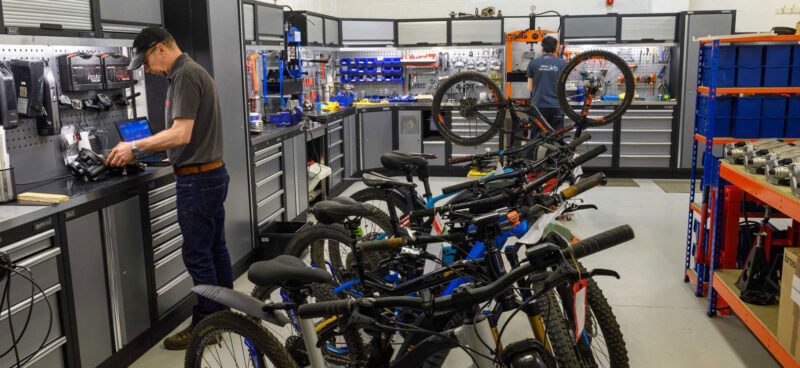
When it comes to your electric bicycle, you may be wondering how often does it need servicing. You might also wonder what parts of your ebike should be cleaned and lubricated. If you want to make sure your drivetrain is running smoothly, you should read this article. You can also learn more about cleaning your electric bike’s components. After all, these parts are important. They are important to maintain your electric bike.
Maintenance of an eBike
Maintaining an eBike is similar to maintaining any other bike. You’ll need to learn a few basic mechanics, as you would with firearms or optics. For more complicated systems, however, you may need to seek professional help. Fortunately, most eBikes are fairly simple, so there’s no reason you shouldn’t learn how to maintain your own eBike. Here are some things you should keep in mind.
Check the drivetrain system. Every eBike has parts that can become worn over time. Check the chain, lubricate it, and replace it if necessary. Also check the spokes and the suspension. The eBike’s gears should be tuned. Tires should also be checked for air pressure and tread. You should also thoroughly inspect the drivetrain system, including grease and grime buildup. Make sure to tighten all nut screws and bolts.
The bike battery should also be checked periodically. Ensure that all bolts are tightly screwed into the frame. If they’re loose, you could lose the warranty. Also, you could damage the battery. If this happens, contact a dealership for help. If it’s an electric bike, the repair costs will be minimal. In addition to extending the life of these components, proper maintenance will increase their lifespan and ensure that they can continue providing excellent service.
Your eBike may need servicing on a regular basis. For example, every six months or every 1,000 miles, you’ll need to service your eBike. The best service schedule for your eBike depends on your riding habits. If you don’t ride very often, you can get away with doing this maintenance once every six months. Those who ride more often and in extreme weather conditions will need to have their bikes serviced more frequently.
Cleaning
After a ride, cleaning your eBike is essential to keeping it in good condition. You can purchase specialist bike cleaning products and use them to clean your eBike properly. These products are safe for your electrical bike because they do not attack the plastics and seals. However, if you want to do it on your own, you can use a washing-up liquid or soap solution. Remember that the cleaning liquid should not be too harsh and should not be strongly degreasing or aggressive to the plastics and components. If you’ve taken your eBike on a trip to the sea, you must also take care to protect the electrical components and avoid causing corrosion.
You should regularly clean your eBike to prevent dirt and grease buildup from causing damage to its components. Regular cleaning is an easy routine maintenance that you can do yourself, but it is important to use the right cleaning products. Avoid using jet washing to clean your eBike, because high-powered hoses can cause corrosion and damage to the internal mechanisms of the eBike. If you clean it properly, you’ll extend the life of your electric bike.
Taking apart the battery, display, and motors is important before cleaning your eBike. During the process, make sure to remove the motors and batteries to protect the motor and battery from water. After removing the battery, remove it from its housing and use a soft brush to clean the magnets and speed sensors. You can also use a bike-specific cleaning product if needed. Make sure to turn off the power before washing to prevent damaging the batteries and the motor.
Lubrication
How often does an ebike need servicing depends on its usage and maintenance needs. Regular maintenance checks include cleaning and lubricating the chain and ensuring it is tight and free of grime. Other basic checks include checking the tire pressure and tread and replacing worn tires. Additionally, the drivetrain system needs to be inspected for dirt and grease buildup. Check for looseness of the chain and tighten all nuts and bolts.
The first step in determining when an ebike needs servicing is to refer to the owner’s manual. The manual should tell you how often it needs servicing. If you have not read the manual, you can obtain it on the manufacturer’s website. If the manual says that the bike needs servicing after a certain number of miles, this likely means you should get it serviced. The recommended servicing interval varies depending on the model, but is typically 600-900 miles, which is approximately 600-900 miles.
In addition to periodic maintenance, ebike owners should consider an annual service. Taking your ebike in for annual service is recommended if you ride it frequently, for instance on a daily basis. Taking your ebike in for a checkup is a good idea once a year, or as needed, after 4,000km. Regular service is also recommended by bike manufacturers to keep the battery running smoothly.
The chain should be lubricated regularly. The owner should apply the lubricant inside the chain links and make sure not to lubricate near the brakes. After cleaning, the chain should be oiled. Chain oil should be applied wet or dry depending on the season. Similarly, cables should be lubricated with light spray oil. The spray oil should leave a PTFE film.
Checking drivetrain
There are several things to consider when servicing an ebike, including chain wear and tire pressure. It is a good idea to check the chain on an ebike every 250 to 500 miles or so, and you should replace the chain after 2,000 miles. For easy access to the chain wear indicator, run a finger along the chain. If the chain is worn, you can check the rollers to see if they’re becoming thinning and elongated.
Another important step in servicing an ebike is lubrication. You may need to change the lubricant or replace the chain altogether. You should also check the suspension and the spokes for firmness. Finally, check the tires for air pressure and tread. You should also change the tires if they’re worn. When it comes to servicing your ebike, there are six steps you should follow. Several of these steps may seem difficult at first, but they’re actually very simple and can become second nature after a bit of practice.
Basic servicing is important for ebikes, but drivetrain maintenance should be left to the professionals. An authorised service representative can update the drive system and update it to manufacturer standards, thus preserving the warranty. Do-it-yourself mechanics can perform basic checks, such as checking tire pressure and barrel adjustment of gears. However, it is highly recommended that you leave the drivetrain to the professionals.
The first component to check is the chain. The chain may be worn and cause noise when you pedal. You can easily check the chain by washing it with dish soap and water and brushing it with a toothbrush. Similarly, your bike’s chain derailleur must be cleaned and greased. These are two of the most vital components of an ebike’s drivetrain. Once these components are properly lubricated, they’ll last much longer.
Checking tyre pressure
When it comes to ebikes, it’s important to know how to check the tyre pressure before you ride. Tire pressure is a variable number, and it depends on a number of factors, including the size of the rider and the terrain they’re going to be riding on. Below is an informational guide to checking the tyre pressure on your ebike before you head to a servicing shop.
In order to avoid damaging your tyres, you must check the pressure of your tyres before riding. This is a simple process. All you need to do is squeeze a tyre. If you feel little resistance, then your tyres may be under-inflated. Make sure you check your tyres at least once a month.
Tire pressure is a critical factor for the performance of an ebike. Correct tire pressure maximizes traction without sacrificing rolling resistance or handling. Since bike riders are lightweight and slow-moving, proper tire pressure is of utmost importance. Checking tyre pressure is one of the easiest regular servicing steps you can perform, and it’s often overlooked by bike owners.
While you’re checking the tire pressure, you may want to consider the type of terrain you’ll be riding on. Rough surfaces can dent tires and wheels. Tire pressure can also affect brake consistency. Tire pressure should be adjusted accordingly based on the surface you’re riding on, as no road or trail is perfectly smooth. Keeping tires properly inflated will extend tire life and prevent flats.

